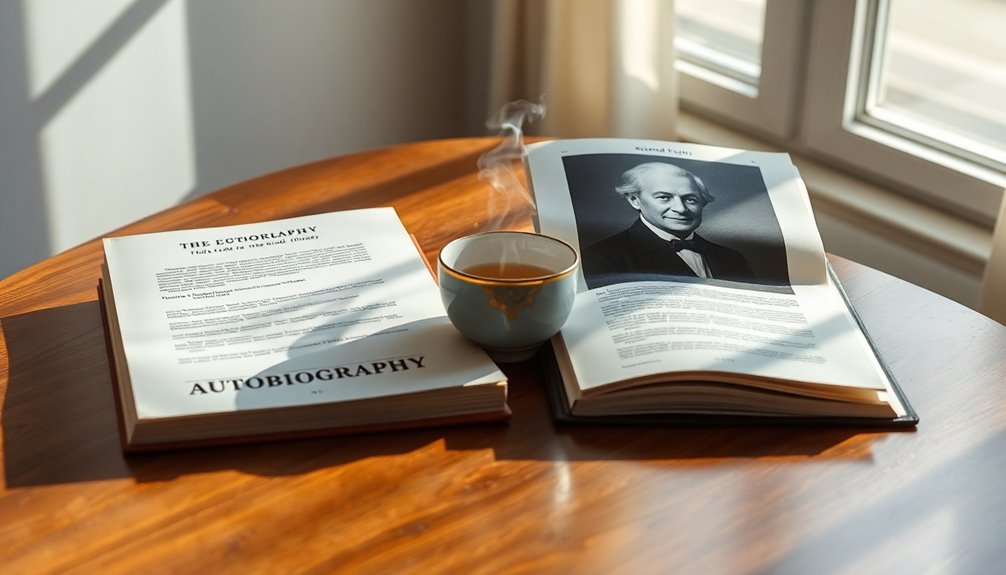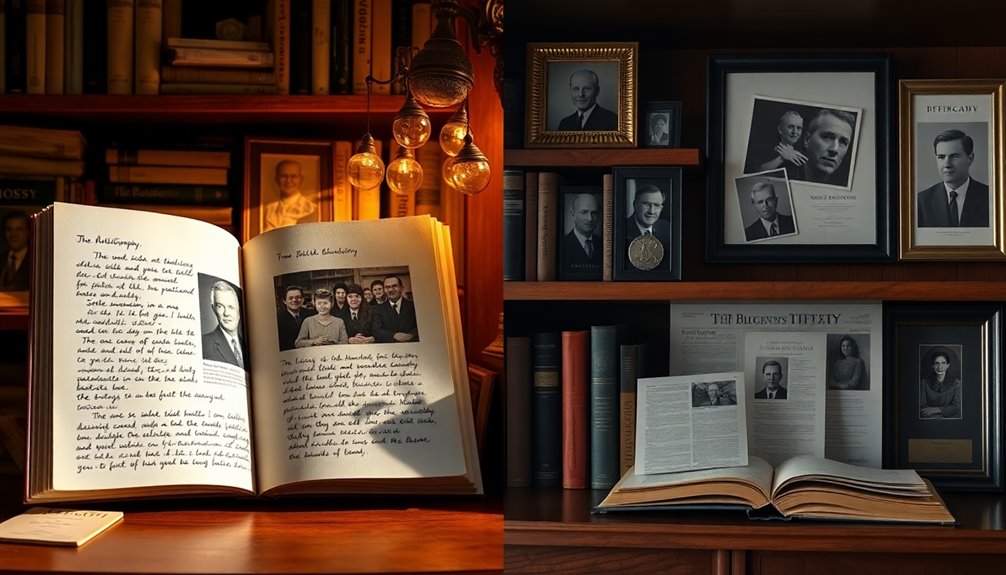An autobiography is a self-written account of your life, sharing personal thoughts and experiences, while a biography is a detailed narrative of someone else's life, focusing on factual events. Autobiographies offer an intimate, first-person perspective, allowing for emotional connections, whereas biographies maintain an objective, third-person viewpoint, providing a broader understanding. The writing style in autobiographies is often narrative-driven with vivid anecdotes, while biographies prioritize factual accuracy. Both genres enrichingly shape our understanding of human experiences, and knowing these differences can enhance your appreciation of each. Explore more to uncover the nuances that make each genre unique.
Key Takeaways
- Autobiographies are written in the first person, offering personal insights, while biographies use a third-person perspective for broader analysis.
- The tone of autobiographies is subjective and emotional, whereas biographies maintain an objective and factual tone.
- Autobiographies focus on personal experiences and reflections, while biographies detail the life events and achievements of another individual.
- Research for autobiographies relies on the author's memories, while biographies require extensive fact-checking from various reliable sources.
- Both genres serve important societal roles: autobiographies preserve personal narratives, while biographies contribute to the collective understanding of historical figures.
Definitions of Autobiography and Biography

When you explore the world of autobiographies and biographies, you'll find that they serve distinct purposes in storytelling. An autobiography is a first-person narrative where the author recounts their own life experiences. You get a firsthand account that reflects the author's unique perspective, emotions, and insights, often structured chronologically from birth to present. It includes essential background information, significant milestones, and personal reflections, creating an intimate connection with the reader.
On the other hand, a biography is written in the third person and offers an objective account of someone else's life. The author isn't the subject; instead, they conduct meticulous research, drawing from various sources like interviews and letters to provide an accurate portrayal. Biographies cover the subject's entire life, from birth to death, focusing on key events that shaped their journey while avoiding personal biases. This process often emphasizes the importance of authenticity and reflection to ensure an accurate depiction of the subject's life.
Both forms share valuable insights but differ in perspective and intent. Autobiographies invite you into the author's world, while biographies provide a broader view of another's life, often illuminating historical or public figures' contributions. Understanding these definitions helps you appreciate the depth of each narrative style.
Purpose and Scope Comparison

When you compare autobiographies and biographies, you see a clear distinction between personal expression and factual information. Autobiographies focus on emotional reflection and the author's unique insights, while biographies aim for objectivity and thorough accounts of a person's life. Understanding these differences helps you appreciate the purpose and scope of each genre. Additionally, the purpose of writing a biography is to preserve legacies for future generations and shed light on significant lives.
Personal Expression vs. Factual Information
An autobiography offers a unique window into the author's personal experiences, thoughts, and emotions, creating a deeply intimate connection with readers. This personal expression is what sets autobiographies apart from biographies, which focus on factual information. When you read an autobiography, you engage with the author's voice, as they share their journey through their own lens.
In contrast, biographies present a more objective account of a person's life. Here's how these two forms differ:
- Autobiographies use a first-person perspective, allowing the author to express their feelings and reflections.
- Biographies are written in the third person, emphasizing factual accuracy and objectivity.
- Autobiographies often incorporate storytelling elements, like dialogue and setting, to draw you in emotionally.
- Biographies rely on meticulous research, drawing from various sources to provide a thorough view of the subject, often including collected facts about the subject's life.
Ultimately, while autobiographies serve as a canvas for personal expression, biographies aim to inform by presenting factual information. Both forms offer valuable insights, but they cater to different aspects of storytelling and understanding a person's life.
Comprehensive Life Coverage
Both autobiographies and biographies provide thorough coverage of a person's life, yet they approach this task with different aims and perspectives. In an autobiography, you explore the author's life from birth to the present, often using personal memories, letters, and photographs. This narrative allows you to connect intimate details to broader themes, revealing the author's experiences and reflections. The purpose is not just to inform but also to leave a legacy and promote personal growth through the writing process. Moreover, autobiographies are characterized by their emphasis on feelings and personal memories, which enhances the storytelling experience.
Conversely, a biography covers the subject's life extensively but often relies on extensive research rather than personal experience. It examines significant events, education, work history, and relationships, aiming to provide an objective view of the subject's contributions. Biographers may include interviews and documents, ensuring accuracy through multiple sources.
While autobiographies draw you into a first-person experience, biographies maintain a third-person perspective, focusing on the subject's impact and historical context. Fundamentally, both forms offer extensive life coverage, but your engagement differs based on the narrative style and the purpose behind the storytelling.
Emotional Reflection vs. Objectivity
While autobiographies invite you into an author's personal world through emotional reflection, biographies present a more objective account of a subject's life. This distinction shapes how you experience each narrative. In autobiographies, you engage deeply with the author's feelings, thoughts, and personal growth, creating an intimate connection. You'll find the following characteristics:
- Personal Perspective: Written in the first person, providing an introspective narrative.
- Emotional Depth: Includes the author's thoughts and feelings, fostering emotional connections.
- Subjective Experience: Presents life events from the author's viewpoint, which may be biased but authentic.
- Reflective Nature: Encourages self-reflection and analysis of life events, showcasing personal insights.
Conversely, biographies focus on delivering a factual and thorough analysis. They maintain a third-person narrative, relying on various sources for accuracy. The main features include:
- Factual Focus: Emphasizes objective information about the subject's life.
- Multiple Sources: Utilizes interviews and documents for reliability.
- Objective Analysis: Minimizes biases while highlighting historical context.
- Thorough Research: Guarantees accuracy through meticulous fact-checking, which is often supported by extensive research.
Writing Style Differences

When you compare autobiographies and biographies, you'll notice key differences in writing style. Autobiographies often showcase a personal voice that invites you into the author's thoughts and feelings, while biographies maintain an objective tone focused on facts. This shift in narrative perspective shapes how you understand each subject's life and emotional landscape. Understanding these different genres aids in crafting compelling narratives.
Personal Voice vs. Objectivity
Autobiographies immerse you in the author's personal experiences and emotions, creating an intimate connection that's often absent in biographies. When you read an autobiography, you're engaging with the author's unique voice, crafted from their own reflections and insights. This first-person perspective allows you to experience their life through their eyes, filled with personal anecdotes that only they can share.
On the other hand, biographies maintain a level of objectivity. They're written from a third-person viewpoint, presenting a more detached account. Here's how they differ:
- Personal Voice: Autobiographies use the author's own words and feelings.
- Factual Accuracy: Biographies focus on verified events and achievements.
- Intimacy: Autobiographies create a close bond between author and reader.
- Research: Biographies require extensive fact-checking to guarantee credibility.
Additionally, biographies are research-based and require extensive research to ensure accuracy and depth of information.
With these distinctions, you can appreciate how each genre serves different purposes. Autobiographies invite you into a personal journey, while biographies offer a thorough, researched narrative that analyzes a subject's life from an external perspective.
Emotional Tone Variations
The emotional tone in autobiographies and biographies highlights their distinct writing styles. When you read an autobiography, you'll notice a subjective experience filled with the author's personal thoughts and feelings. The first-person narrative creates an intimate connection, drawing you into their emotional journey of struggles and triumphs. You get a sense of their personal growth and self-awareness, even if it's tinged with bias due to their perspective.
In contrast, biographies present a more objective narrative. Written in the third person, they focus on factual accuracy rather than emotional depth. You'll find that the tone is more detached, as the writer aims to provide a thorough coverage of the subject's life without the personal emotions of the individual. Biographies rely heavily on research from various sources, which lends an analytical approach to the subject's life events and contributions. This lack of emotional engagement can make the reading experience feel more like an informative account rather than an intimate story, shifting your focus from personal feelings to factual detailing. Understanding these emotional tone variations helps you appreciate the unique storytelling methods of each genre.
Narrative Perspective Shift
Narrative perspective plays an essential role in distinguishing autobiographies from biographies. When you explore these two genres, you'll quickly notice how the point of view shapes the reader's experience.
- Autobiography: Written in the first person, it creates an intimate connection through personal reflections and experiences.
- Biography: Written in the third person, it offers a more formal and objective analysis of the subject's life.
In an autobiography, you become the subject, sharing your thoughts and feelings directly. This narrative style is often introspective, allowing you to investigate your internal world. Conversely, a biography presents an external view, focusing on factual accuracy and historical context.
Moreover, the author's role differs considerably. In an autobiography, you're sharing your journey, while in a biography, the author is someone else, aiming to provide a thorough account of another's life.
Tone and Perspective Variations

When exploring the tone and perspective variations between autobiography and biography, you'll notice distinct differences that shape the reader's experience. In an autobiography, the tone is often personal and introspective. You'll find the author sharing their thoughts and feelings, which creates an emotional and reflective atmosphere. This subjective viewpoint, filled with personal anecdotes, invites you into the author's inner world.
Conversely, a biography adopts a more objective and factual tone. It focuses on accuracy and historical context, so you'll see less emotion and a more formal approach. The author aims to present a broader, balanced view of the subject's life, often including analysis and interpretation.
Regarding perspective, autobiographies are written in the first person, making the author both the main character and narrator. This perspective fosters an intimate connection with you, the reader, often employing flashbacks or thematic organization based on personal memories.
On the other hand, biographies are written in the third person, allowing the author to take on the role of an external observer. This detached viewpoint relies on meticulous research and fact-checking, offering you a more thorough understanding of the subject's life.
Audience Engagement Strategies

Engaging an audience in autobiographies relies heavily on personal narratives that resonate deeply with readers. To capture their attention and maintain interest, you can employ several strategies that enhance the connection between you and your readers.
- Intimate Voice: Using a first-person narrative creates a closeness that draws readers into your world.
- Vivid Anecdotes: Personal stories and vivid details keep the narrative lively and relatable.
- Reflective Tone: Inviting readers to reflect on their own experiences fosters a deeper engagement with your story.
- Honesty and Vulnerability: Sharing your struggles and triumphs builds trust, encouraging readers to invest emotionally in your journey. Additionally, incorporating themes of improved cognitive function can highlight the mental clarity gained through personal growth experiences.
Research and Accuracy Requirements

In crafting autobiographies and biographies, understanding the research and accuracy requirements is essential for authenticity and credibility. When you write an autobiography, you primarily draw from your personal memories, experiences, and memorabilia like letters and photographs. This form allows for extensive self-reflection but relies heavily on your subjective narrative. While you might collaborate with ghostwriters for factual accuracy, the fact-checking process isn't as stringent as in biographies.
On the other hand, biographies demand meticulous research and a variety of sources. You'll gather information from interviews, historical records, and personal documents to guarantee an objective perspective. Biographies require verification through multiple sources, aiming for a thorough view of the subject's life. The third-person narrative style aims for a balanced account, often involving collaboration with historians or experts.
Ultimately, both forms need accuracy, but the approach differs. Autobiographies focus on personal insight, while biographies emphasize factual integrity and objectivity. Understanding these distinctions will guide you in crafting a compelling narrative, whether it's your own story or someone else's.
Notable Examples and Works

Understanding the different styles and themes in autobiographies and biographies helps you appreciate the unique narratives these works present. Notable examples in each genre showcase the diverse experiences and insights of their authors, enriching your understanding of human stories.
Here are some remarkable autobiographies:
- The Diary of a Young Girl by Anne Frank: Chronicles her life in hiding during WWII.
- I Know Why the Caged Bird Sings by Maya Angelou: Explores her early life, racism, and personal struggles.
- Long Walk to Freedom by Nelson Mandela: Details his life from childhood to his presidency.
- Man's Search for Meaning by Viktor E. Frankl: Describes his experiences in Nazi concentration camps.
On the biography side, consider these notable works:
- Steve Jobs by Walter Isaacson: A thorough biography of the Apple co-founder.
- The Immortal Life of Henrietta Lacks by Rebecca Skloot: Tells the story of Henrietta Lacks and her immortal cells.
- Marie Curie: A Life by Susan Quinn: Details the life and achievements of the renowned scientist.
- Albert Einstein: His Life and Universe by Walter Isaacson: Explores Einstein's life, theories, and impact. Biographies often rely on in-depth research to provide accurate and balanced portrayals of their subjects.
These examples reflect the powerful narratives found in both autobiographies and biographies.
The Impact of Each Genre

While both autobiographies and biographies serve to tell compelling human stories, they each leave distinct impacts on readers and society. Autobiographies offer a personal reflection, allowing you to dive deep into the author's life, thoughts, and emotions. This first-person narrative creates an intimate connection, letting you relate more closely to the author's experiences. Such insights can inspire personal growth and resonate with your own life, making their stories priceless for future generations.
On the other hand, biographies provide an objective and thorough view of a subject's life. By focusing on factual accounts and meticulous research, they present a broader understanding of the individual's contributions to society. This third-person perspective may lack the intimacy of autobiographies but compensates with informative depth. Biographies not only educate you about the subject's achievements but also highlight their cultural and historical significance.
In essence, autobiographies touch your heart while biographies inform your mind. Both genres play indispensable roles in shaping societal understanding and appreciation of human experiences, making them crucial for your personal and collective growth.
Frequently Asked Questions
Can Autobiographies Include Fictional Elements or Embellishments?
Imagine a painter, blending colors on canvas. While autobiographies can include personal reflections, they shouldn't stray too far into fiction. You want authenticity, so stick to true events and avoid unnecessary embellishments for credibility.
How Do Cultural Differences Affect Autobiography and Biography Writing?
Cultural differences shape how you approach autobiography and biography writing. In individualistic cultures, you might emphasize personal achievements, while collectivist cultures focus on community. These influences affect narrative style, personal disclosure, and the depth of content shared.
Are There Specific Genres Within Autobiographies and Biographies?
You might think all autobiographies and biographies are the same, but you'll find they vary widely. From memoirs to authorized accounts, each genre offers unique insights, styles, and structures, making every story truly one-of-a-kind.
How Do Age and Life Experience Influence Autobiographical Writing?
Age and life experience shape your autobiographical writing by enhancing depth and authenticity. As you reflect on significant events, your insights grow richer, allowing you to connect more deeply with readers through relatable narratives.
What Are the Ethical Considerations in Writing Biographies?
When writing biographies, you need to take into account accuracy, permission, and objectivity. Respect the subject's privacy, avoid biases, and guarantee your portrayal is fair, transparent, and sensitive to the potential impact on their family and friends.









